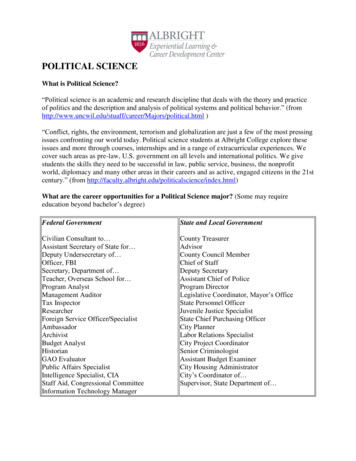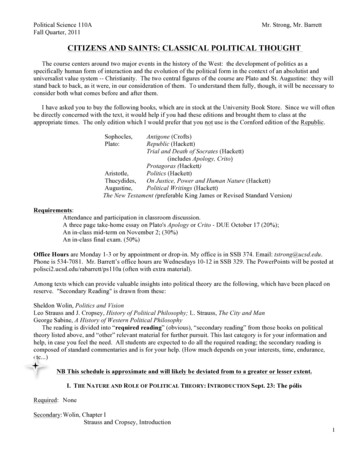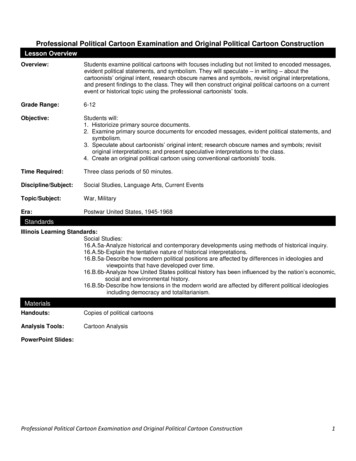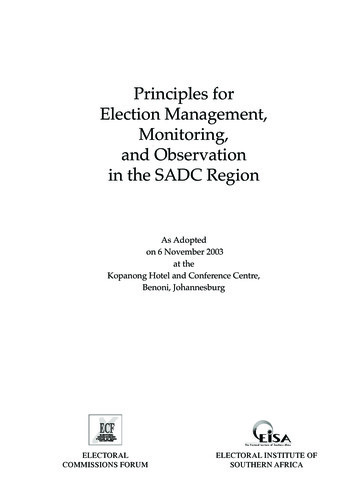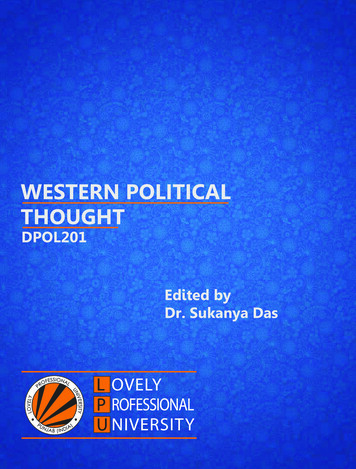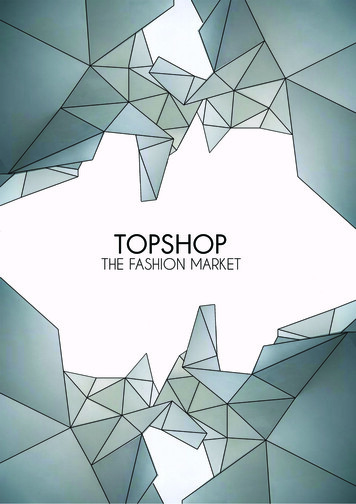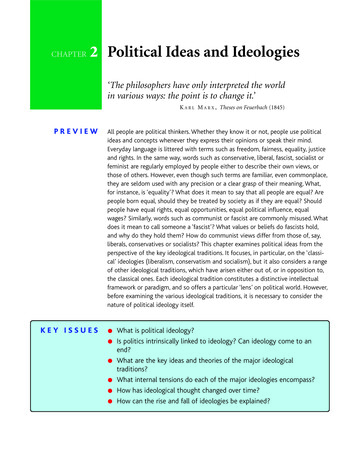
Transcription
CHAPTER2 Political Ideas and Ideologies‘The philosophers have only interpreted the worldin various ways: the point is to change it.’K A R L M A R X , Theses on Feuerbach (1845)PREVIEWKEY ISSUESAll people are political thinkers. Whether they know it or not, people use politicalideas and concepts whenever they express their opinions or speak their mind.Everyday language is littered with terms such as freedom, fairness, equality, justiceand rights. In the same way, words such as conservative, liberal, fascist, socialist orfeminist are regularly employed by people either to describe their own views, orthose of others. However, even though such terms are familiar, even commonplace,they are seldom used with any precision or a clear grasp of their meaning. What,for instance, is ‘equality’? What does it mean to say that all people are equal? Arepeople born equal, should they be treated by society as if they are equal? Shouldpeople have equal rights, equal opportunities, equal political influence, equalwages? Similarly, words such as communist or fascist are commonly misused. Whatdoes it mean to call someone a ‘fascist’? What values or beliefs do fascists hold,and why do they hold them? How do communist views differ from those of, say,liberals, conservatives or socialists? This chapter examines political ideas from theperspective of the key ideological traditions. It focuses, in particular, on the ‘classical’ ideologies (liberalism, conservatism and socialism), but it also considers a rangeof other ideological traditions, which have arisen either out of, or in opposition to,the classical ones. Each ideological tradition constitutes a distinctive intellectualframework or paradigm, and so offers a particular ‘lens’ on political world. However,before examining the various ideological traditions, it is necessary to consider thenature of political ideology itself.l What is political ideology?l Is politics intrinsically linked to ideology? Can ideology come to anend?l What are the key ideas and theories of the major ideologicaltraditions?l What internal tensions do each of the major ideologies encompass?l How has ideological thought changed over time?l How can the rise and fall of ideologies be explained?
28POLITICSCONCEPTIdeologyFrom a social-scientificviewpoint, an ideology isa more or less coherentset of ideas that providesa basis for organizedpolitical action, whetherthis is intended topreserve, modify oroverthrow the existingsystem of powerrelationships. Allideologies therefore (1)offer an account of theexisting order, usually inthe form of a ‘worldview’, (2) provide amodel of a desired future,a vision of the GoodSociety, and (3) outlinehow political change canand should be broughtabout. Ideologies are not,however, hermeticallysealed systems ofthought; rather, they arefluid sets of ideas thatoverlap with one anotherat a number of points.WHAT IS POLITICAL IDEOLOGY?Ideology is one of the most controversial concepts encountered in politicalanalysis. Although the term now tends to be used in a neutral sense, to refer to adeveloped social philosophy or world-view, it has in the past had heavily negativeor pejorative connotations. During its sometimes tortuous career, the concept ofideology has commonly been used as a political weapon to condemn or criticizerival creeds or doctrines.The term ‘ideology’ was coined in 1796 by the French philosopher Destutt deTracy (1754–1836). He used it to refer to a new ‘science of ideas’ (literally, anidea-ology) that set out to uncover the origins of conscious thought and ideas.De Tracy’s hope was that ideology would eventually enjoy the same status asestablished sciences such as zoology and biology. However, a more enduringmeaning was assigned to the term in the nineteenth century in the writings ofKarl Marx (see p. 41). For Marx, ideology amounted to the ideas of the ‘rulingclass’, ideas that therefore uphold the class system and perpetuate exploitation. Intheir early work The German Ideology, Marx and Engels wrote the following:The ideas of the ruling class are in every epoch the ruling ideas, i.e. the classwhich is the ruling material force in society, is at the same time the rulingintellectual force. The class which has the means of mental production at itsdisposal, has control at the same time over the means of mental production.(Marx and Engels, [1846] 1970:64)The defining feature of ideology in the Marxist sense is that it is false: it mystifiesand confuses subordinate classes by concealing from them the contradictions onwhich all class societies are based. As far as capitalism is concerned, the ideologyof the property-owning bourgeoisie (bourgeois ideology) fosters delusion or ‘falseconsciousness’ amongst the exploited proletariat, preventing them from recognizing the fact of their own exploitation. Nevertheless, Marx did not believe that allpolitical views had an ideological character. He held that his own work, whichattempted to uncover the process of class exploitation and oppression, was scientific. In his view, a clear distinction could be drawn between science and ideology,between truth and falsehood. This distinction tended, however, to be blurred inthe writings of later Marxists such as Lenin (see p. 99) and Gramsci (see p. 175).These referred not only to ‘bourgeois ideology’, but also to ‘socialist ideology’ or‘proletarian ideology’, terms that Marx would have considered absurd.Alternative uses of the term have also been developed by liberals and conservatives. The emergence of totalitarian dictatorships in the interwar periodencouraged writers such as Karl Popper (1902–94), J. L. Talmon and HannahArendt (see p. 7) to view ideology as an instrument of social control to ensurecompliance and subordination. Relying heavily on the examples of fascism andcommunism, this Cold War liberal use of the term treated ideology as a ‘closed’system of thought, which, by claiming a monopoly of truth, refuses to tolerateopposing ideas and rival beliefs. In contrast, liberalism, based as it is on a fundamental commitment to individual freedom, and doctrines such as conservatismand democratic socialism that broadly subscribe to liberal principles are clearlynot ideologies. These doctrines are ‘open’ in the sense that they permit, and eveninsist on, free debate, opposition and criticism.
POLITICAL IDEAS AND IDEOLOGIES29Debating . . .Can politics exist without ideology?The term ‘ideology’ has traditionally carried pejorative implications, often expressed through predictions of its imminent(and usually welcome) demise. Nevertheless, despite its varied obituaries, political ideology has stubbornly refused to die:while particular ideologies may rise or fall, ideological forms of politics seem to be an enduring feature of world history.Is politics intrinsically linked to ideology? Or may politics finally be able to emerge from the shadow cast by ideologicalbelief?YESOvercoming falsehood and delusion. Most critiques ofideology associate it with falsehood and manipulation,implying that reason and critical understanding can, andwill, emancipate us from ideological politics. In this view,ideologies are, in effect, political religions, sets of values,theories and doctrines that demand faith and commitment from ‘believers’, who are then unable to think outsideor beyond their chosen world-view. If ideologies are intellectual prisons, the solution is to see the world ‘as it is’,something that can be achieved through the application ofvalue-free scientific method. The purpose of politicalscience is thus to disengage politics from ideology.Rise of technocratic politics. Political ideology arose inthe form of contrasting attempts to shape emergentindustrial society. The left/right divide (see p. 225) andthe struggle between socialism and capitalism has alwaysbeen at the heart of ideological debate. However, thecollapse of communism and the near worldwide acceptance of market capitalism means that this rivalry hasbecome irrelevant to modern politics. Politics has therefore come to revolve not around ideological questions todo with ownership and the distribution of wealth, butaround ‘smaller’ questions to do with the effectivemanagement of the capitalist system. Ideological politicshas given way to technocratic politics.Rise of consumerist politics. Ideology has little place inmodern democratic systems due to the logic of electoralcompetition. Elections force political parties to behavelike businesses in the marketplace, formulating ‘products’(policies) in the hope of attracting the largest number of‘consumers’ (voters). Parties thus increasingly respond toconsumer/voter demands, rather than trying to reshapethese demands in the light of a pre-existing ideologicalvision. Whether parties have historically been left-wing,right-wing or centrist in orientation, they recognise theelectoral value of ‘travelling light’ in ideological terms.Electoral politics therefore contributes to a process ofparty de-ideologization.NOIdeology as an intellectual framework. Political ideologywill always survive because it provides politicians, partiesand other political actors with an intellectual frameworkwhich helps them to make sense of the world in whichthey live. Ideologies are not systematic delusions but,rather, rival visions of the political world, each illuminating particular aspects of a complex and multifacetedreality. Ideologies are therefore neither, in a simplisticsense, true nor false. Perhaps the most dangerous delusion is the notion of a clear distinction between scienceand ideology. Science itself is constructed on the basis ofparadigms that are destined to be displaced over time(Kuhn, 1962).Ideological renewal. The secret of ideology’s survival andcontinued relevance is its flexibility, the fact that ideological traditions go through a seemingly endless process ofredefinition and renewal. As old ideologies fade, newones emerge, helping to preserve the relevance of political ideology. The world of ideologies does not stand still,but changes in response to changing social and historicalcircumstances. The declining relevance of the left/rightdivide has not led to the ‘end of ideology’ or the ‘end ofhistory’; it has merely opened up new ideological spacesthat have been filled by the likes of feminism, green politics, multiculturalism and cosmopolitanism.The ‘vision thing’. As the principal source of meaningand idealism in politics, ideology touches those aspects ofpolitics that no other political form can reach. Ideologygives people a reason to believe in something larger thanthemselves, because people’s personal narratives onlymake sense when they are situated within a broaderhistorical narrative. A post-ideological age would therefore be an age without hope, without vision. If politicianscannot cloak their pursuit of power in ideologicalpurpose, they risk being seen simply as power-seekingpragmatists, and their policy programmes will appear tolack coherence and direction.
30POLITICSl Rationalism: The belief thatthe world can be understoodand explained through theexercise of human reason,based on assumptions about itsrational structure.l Pragmatism: A theory orpractice that places primaryemphasis on practicalcircumstances and goals;pragmatism implies a distrustof abstract ideas.A distinctively conservative use of the term ‘ideology’ has been developed bythinkers such as Michael Oakeshott (see p. 177). This view reflects a characteristically conservative scepticism about the value of rationalism, born out of thebelief that the world is largely beyond the capacity of the human mind tofathom. As Oakeshott put it, in political activity ‘men sail a boundless andbottomless sea’. From this perspective, ideologies are seen as abstract ‘systems ofthought’; that is, as sets of ideas that distort political reality because they claimto explain what is, frankly, incomprehensible. This is why conservatives havetraditionally dismissed the notion that they subscribe to an ideology, preferringinstead to describe conservatism as a disposition, or an ‘attitude of mind’, andplacing their faith in pragmatism, tradition (see p. 82) and history.The drawback of each of these usages, however, is that, as they are negative orpejorative, they restrict the application of the term. Certain political doctrines,in other words, are excluded from the category of ‘ideologies’. Marx, for instance,insisted that his ideas were scientific, not ideological, liberals have denied thatliberalism should be viewed as an ideology, and conservatives have traditionallyclaimed to embrace a pragmatic rather than ideological style of politics.Moreover, each of these definitions is loaded with the values and orientation ofa particular political doctrine. An inclusive definition of ‘ideology’ (one thatapplies to all political traditions) must therefore be neutral: it must reject thenotion that ideologies are ‘good’ or ‘bad’, true or false, or liberating or oppressive.This is the virtue of the modern, social-scientific meaning of the term, whichtreats ideology as an action-orientated belief system, an interrelated set of ideasthat in some way guides or inspires political action.However, much of the debate about ideology since the mid-twentieth centuryhas focused on predictions of its demise, or at least of its fading relevance. Thiscame to be known as the ‘end of ideology’ debate. It was initiated in the 1950s,stimulated by the collapse of fascism at the end of World War II and the declineof communism in the developed West. In The End of Ideology (1960), the USsociologist Daniel Bell (1919–2011) declared that the stock of political ideas hadbeen exhausted. In his view, ethical and ideological questions had become irrelevant because in most western societies parties competed for power simply bypromising higher levels of economic growth and material affluence. This debatewas revived in the aftermath of the collapse of communism by ‘end of history’theorists, such as Fukuyama (see p. 271), who suggested that a single ideology,liberal democracy, had triumphed over all its rivals, and that this triumph wasfinal (see p. 44). At the heart of such debates lies questions about the relationshipbetween politics and ideology, and specifically about whether politics can existwithout ideology (see p. 29).CLASSICAL IDEOLOGICAL TRADITIONSPolitical ideology arose out of the transition from feudalism to industrial capitalism. In simple terms, the earliest, or ‘classical’ ideologies – liberalism, conservatism and socialism – developed as contrasting attempts to shape emergingindustrial society. This meant that the central theme in ideological debate andargument during this period and beyond was the battle between two rivaleconomic philosophies: capitalism (see p. 131) and socialism. Political ideology
POLITICAL IDEAS AND IDEOLOGIES31John Locke (1632–1704)English philosopher and politician. Locke studied medicine at Oxford Universitybefore becoming secretary to Anthony Ashley Cooper, First Earl of Shaftsbury, in1661. His political views were developed against the backdrop of the EnglishRevolution, and are often seen as providing a justification for the ‘Glorious Revolution’of 1688, which ended absolutist rule and established a constitutional monarchy inBritain. Locke was a key thinker of early liberalism, placing particular emphasis on‘natural’ or God-given rights, identified as the rights to life, liberty and property. Anexponent of representative government and toleration, Locke’s views had a considerable impact on the American Revolution. His most important political works are ALetter Concerning Toleration (1689) and Two Treatises of Government ([1690] 1965).thus had a strong economic focus. The battle lines between capitalism andsocialism were significantly sharpened by the 1917 Russian Revolution, whichcreated the world’s first socialist state. Indeed, throughout what is sometimescalled the ‘short’ twentieth century (from the outbreak of World War I to the fallof communism, 1989–91), and particularly during the Cold War period(1945–90), international politics was structured along ideological lines, as thecapitalist West confronted the communist East. Although ideological debate hasbecame richer and certainly progressively more diverse since the 1960s, not leastas a result of the rise of so-called ‘new’ ideologies such as feminism and greenpolitics, the classical ideologies have retain their central importance. In largepart, this has been because of their capacity to reinvent themselves. In the processof doing so, the dividing lines between them have often been blurred.Liberalisml Meta-ideology: A higher orsecond-order ideology that laysdown the grounds on whichideological debate can takeplace.Any account of political ideologies must start with liberalism. This is becauseliberalism is, in effect, the ideology of the industrialized West, and is sometimesportrayed as a meta-ideology that is capable of embracing a broad range of rivalvalues and beliefs. Although liberalism did not emerge as a developed politicalcreed until the early nineteenth century, distinctively liberal theories and principles had gradually been developed during the previous 300 years. Early liberalismcertainly reflected the aspirations of a rising industrial middle class, and liberalism and capitalism have been closely linked (some have argued intrinsicallylinked) ever since. In its earliest form, liberalism was a political doctrine. Asrelected in the ideas of thinkers such as John Locke, it attacked absolutism (see p.268) and feudal privilege, instead advocating constitutional and, later, representative government. By the early nineteenth century, a distinctively liberal economiccreed had developed that extolled the virtues of laissez-faire (see p. 132) andcondemned all forms of government intervention. This became the centrepiece ofclassical, or nineteenth-century, liberalism. From the late nineteenth centuryonwards, however, a form of social liberalism emerged that looked morefavourably on welfare reform and economic intervention. Such an emphasisbecame the characteristic theme of modern, or twentieth-century, liberalism.
32POLITICSLiberalism: key ideas Individualism: Individualism (see p. 158) is the core principle of liberal ideology. It reflects a belief in thesupreme importance of the human individual as opposed to any social group or collective body. Humanbeings are seen, first and foremost, as individuals. This implies both that they are of equal moral worth andthat they possess separate and unique identities. The liberal goal is therefore to construct a society withinwhich individuals can flourish and develop, each pursuing ‘the good’ as he or she defines it, to the best of hisor her abilities. This has contributed to the view that liberalism is morally neutral, in the sense that it laysdown a set of rules that allow individuals to make their own moral decisions. Freedom: Individual freedom (see p. 339), or liberty (the two terms are interchangeable), is the core value ofliberalism; it is given priority over, say, equality, justice or authority. This arises naturally from a belief in theindividual and the desire to ensure that each person is able to act as he or she pleases or chooses. Nevertheless,liberals advocate ‘freedom under the law’, as they recognize that one person’s liberty may be a threat to theliberty of others; liberty may become licence. They therefore endorse the ideal that individuals should enjoythe maximum possible liberty consistent with a like liberty for all. Reason: Liberals believe that the world has a rational structure, and that this can be uncovered through theexercise of human reason and by critical enquiry. This inclines them to place their faith in the ability of individuals to make wise judgements on their own behalf, being, in most cases, the best judges of their own interests. It also encourages liberals to believe in progress and the capacity of human beings to resolve theirdifferences through debate and argument, rather than bloodshed and war. Equality: Individualism implies a belief in foundational equality: that is, the belief that individuals are ‘bornequal’, at least in terms of moral worth. This is reflected in a liberal commitment to equal rights and entitlements, notably in the form of legal equality (‘equality before the law’) and political equality (‘one person, onevote; one vote, one value’). However, as individuals do not possess the same levels of talent or willingness towork, liberals do not endorse social equality or an equality of outcome. Rather, they favour equality of opportunity (a ‘level playing field’) that gives all individuals an equal chance to realize their unequal potential.Liberals therefore support the principle of meritocracy, with merit reflecting, crudely, talent plus hard work. Toleration: Liberals believe that toleration (that is, forbearance: the willingness of people to allow others tothink, speak and act in ways of which they disapprove) is both a guarantee of individual liberty and a means ofsocial enrichment. They believe that pluralism (see p. 100), in the form of moral, cultural and political diversity, is positively healthy: it promotes debate and intellectual progress by ensuring that all beliefs are tested in afree market of ideas. Liberals, moreover, tend to believe that there is a balance or natural harmony betweenrival views and interests, and thus usually discount the idea of irreconcilable conflict. Consent: In the liberal view, authority and social relationships should always be based on consent or willingagreement. Government must therefore be based on the ‘consent of the governed’. This is a doctrine thatencourages liberals to favour representation (see p. 197) and democracy, notably in the form of liberal democracy (see p. 270). Similarly, social bodies and associations are formed through contracts willingly entered intoby individuals intent on pursuing their own self-interest. In this sense, authority arises ‘from below’ and isalways grounded in legitimacy (see p. 81). Constitutionalism: Although liberals see government as a vital guarantee of order and stability in society, theyare constantly aware of the danger that government may become a tyranny against the individual (‘powertends to corrupt’ (Lord Acton)). They therefore believe in limited government. This goal can be attainedthrough the fragmentation of government power, by the creation of checks and balances amongst the variousinstitutions of government, and by the establishment of a codified or ‘written’ constitution embodying a bill ofrights that defines the relationship between the state and the individual.
POLITICAL IDEAS AND IDEOLOGIES33Classical liberalismThe central theme of classical liberalism is a commitment to an extreme form ofindividualism. Human beings are seen as egoistical, self-seeking and largely selfreliant creatures. In what C. B. Macpherson (1962) termed ‘possessive individualism’, they are taken to be the proprietors of their own persons and capacities,owing nothing to society or to other individuals. This atomist view of society isunderpinned by a belief in ‘negative’ liberty, meaning non-interference, or theabsence of external constraints on the individual. This implies a deeply unsympathetic attitude towards the state and all forms of government intervention.In Tom Paine’s (see p. 199) words, the state is a ‘necessary evil’. It is ‘necessary’in that, at the very least, it establishes order and security, and ensures thatcontracts are enforced. However, it is ‘evil’ in that it imposes a collective will onsociety, thus limiting the freedom and responsibilities of the individual. The classical liberal ideal is therefore the establishment of a minimal or ‘nightwatchman’state, with a role that is limited to the protection of citizens from the encroachments of fellow citizens. In the form of economic liberalism, this position isunderpinned by a deep faith in the mechanisms of the free market and the beliefthat the economy works best when left alone by government. Laissez-faire capitalism is thus seen as guaranteeing prosperity, upholding individual liberty, and, asthis allows individuals to rise and fall according to merit, ensuring social justice.l Progress: Moving forwards;the belief that history ischaracterized by humanadvancement based on theaccumulation of knowledge andwisdom.l Meritocracy: Rule by thetalented; the principle thatrewards and positions should bedistributed on the basis ofability.l Atomism: The belief thatsociety is made up of acollection of largely selfsufficient individuals who owelittle or nothing to one another.l Economic liberalism: Abelief in the market as a selfregulating mechanism tendingnaturally to deliver generalprosperity and opportunities forall.l Big government:Interventionist government,usually understood to implyeconomic management andsocial regulation.Modern liberalismModern liberalism is characterized by a more sympathetic attitude towards stateintervention. Indeed, in the USA, the term ‘liberal’ is invariably taken to implysupport for ‘big’ government rather than ‘minimal’ government. This shift wasborn out of the recognition that industrial capitalism had merely generated newforms of injustice and left the mass of the population subject to the vagaries ofthe market. Influenced by the work of J. S. Mill (see p. 198), the so-called ‘NewLiberals’ (figures such as T. H. Green (1836–82), L. T. Hobhouse (1864–1929)and J. A. Hobson (1858–1940)) championed a broader, ‘positive’ view offreedom. From this perspective, freedom does not just mean being left alone,which might imply nothing more than the freedom to starve. Rather, it is linkedto personal development and the flourishing of the individual; that is, the abilityof the individual to gain fulfilment and achieve self-realization.This view provided the basis for social or welfare liberalism. This is characterized by the recognition that state intervention, particularly in the form ofsocial welfare, can enlarge liberty by safeguarding individuals from the socialevils that blight individual existence. These evils were identified in the UK by the1942 Beveridge Report as the ‘five giants’: want, ignorance, idleness, squalor anddisease. In the same way, modern liberals abandoned their belief in laissez-fairecapitalism, largely as a result of J. M. Keynes’ (see p. 137) insight that growth andprosperity could be maintained only through a system of managed or regulatedcapitalism, with key economic responsibilities being placed in the hands of thestate. Nevertheless, modern liberals’ support for collective provision and government intervention has always been conditional. Their concern has been with theplight of the weak and vulnerable, those who are literally not able to help themselves. Their goal is to raise individuals to the point where they are able, once
34POLITICSagain, to take responsibility for their own circumstances and make their ownmoral choices. The most influential modern attempt to reconcile the principlesof liberalism with the politics of welfare and redistribution was undertaken byJohn Rawls (see p. 45). (The liberal approach to international politics is examined in Chapter 18.)Conservatisml Redistribution: A narrowingof material inequalities broughtabout through a combinationof progressive taxation andwelfare provision.l Ancien régime: (French)Literally, ‘old order’; usuallylinked with the absolutiststructures that predated theFrench Revolution.l Paternalism: An attitude orpolicy that demonstrates careor concern for those unable tohelp themselves, as in the(supposed) relationshipbetween a father and a child.l Noblesse oblige: (French)Literally, the ‘obligations of thenobility’; in general terms, theresponsibility to guide orprotect those less fortunate orless privileged.l Toryism: An ideologicalstance within conservatismcharacterized by a belief inhierarchy, an emphasis ontradition, and support for dutyand organicism.l Natural aristocracy: Theidea that talent and leadershipare innate or inbred qualitiesthat cannot be acquiredthrough effort or selfadvancement.Conservative ideas and doctrines first emerged in the late eighteenth centuryand early nineteenth century. They arose as a reaction against the growing paceof economic and political change, which was in many ways symbolized by theFrench Revolution. In this sense, conservatism harked back to the ancienrégime. In trying to resist the pressures unleashed by the growth of liberalism,socialism and nationalism, conservatism stood in defence of an increasinglyembattled traditional social order. However, from the outset, divisions inconservative thought were apparent. In continental Europe, a form of conservatism emerged that was characterized by the work of thinkers such as Josephde Maistre (1753–1821). This conservatism was starkly autocratic and reactionary, rejecting out of hand any idea of reform. A more cautious, more flexible and, ultimately, more successful form of conservatism neverthelessdeveloped in the UK and the USA, characterized by Edmund Burke’s belief in‘change in order to conserve’. This stance enabled conservatives in the nineteenth century to embrace the cause of social reform under the paternalisticbanner of ‘One Nation’. The high point of this tradition in the UK came in the1950s as the Conservative Party came to accept the postwar settlement andespouse its own version of Keynesian social democracy. However, such ideasincreasingly came under pressure from the 1970s onwards as a result of theemergence of the New Right. The New Right’s radically antistatist and antipaternalist brand of conservatism draws heavily on classical liberal themes andvalues.Paternalistic conservatismThe paternalistic strand in conservative thought is entirely consistent withprinciples such as organicism, hierarchy and duty, and it can therefore be seen asan outgrowth of traditi
CHAPTER 2 Political Ideas and Ideologies ‘The philosophers have only interpreted the world in various ways: the point is to change it.’ KARL MARX, Theses on Feuerbach(1845) PREVIEW All people are political thinkers. Whether t

